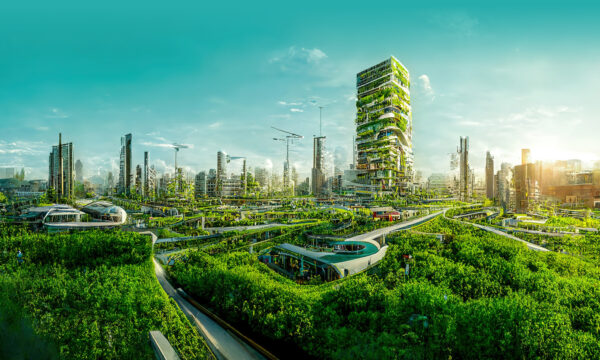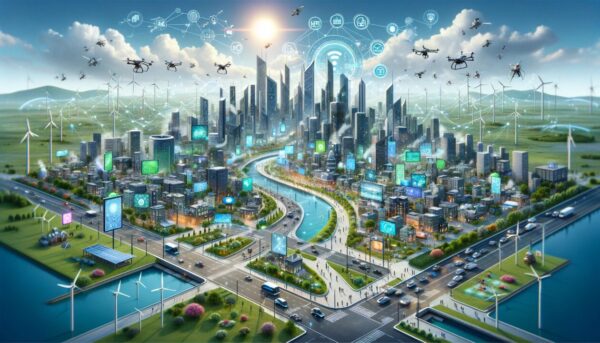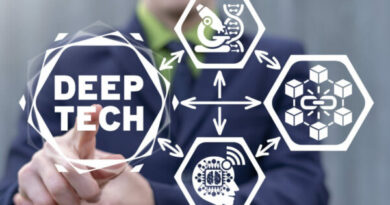Smart Cities: The Urban Revolution Redefining Tomorrow’s Living Spaces
Urban living is on the cusp of a profound transformation, with smart cities spearheading a new era of interconnected, sustainable, and efficient environments. These cities, which seamlessly blend advanced technologies with everyday life, are set to redefine how we interact with our surroundings, enhancing not only the functionality of our urban spaces but also the quality of life for their inhabitants. But what exactly constitutes a smart city, and why is it being heralded as the next frontier in urban development? Let’s explore the evolving concept of smart cities and delve into the technologies and ideas driving this monumental shift in how we live and work.
Defining the Smart City: More Than Just Technology
A smart city is often envisioned as a futuristic metropolis brimming with cutting-edge technology, but its essence goes far beyond that. At its core, a smart city is an integrated ecosystem where infrastructure, data, and human interaction converge to create a living environment that is more responsive, sustainable, and resilient than ever before. Let’s break down what truly makes a city “smart”:
- Integrated and Adaptive Infrastructure:
The foundation of any smart city lies in its infrastructure—transportation systems, energy grids, water management, and communication networks—that is designed to be both interconnected and adaptive. These systems use real-time data to optimize their functions, ensuring that resources are used efficiently and that services are responsive to the changing needs of the city and its residents. - Data as the Driving Force:
In a smart city, data is not just collected for analysis; it is actively used to inform decision-making across all aspects of urban life. From traffic management to public health monitoring, data-driven insights allow cities to anticipate challenges, respond swiftly to emergencies, and continuously improve the urban experience. This data-centric approach enables cities to operate with greater precision and foresight, leading to smarter governance and enhanced public services. - Sustainability at the Forefront:
Sustainability is not just an add-on in smart cities; it is a guiding principle. These cities are designed to minimize their environmental impact through energy-efficient buildings, renewable energy sources, and intelligent waste management systems. By prioritizing sustainability, smart cities aim to reduce carbon footprints, conserve natural resources, and create healthier living environments for current and future generations. - Engaged and Empowered Citizens:
A truly smart city recognizes that its greatest asset is its people. Through digital platforms, mobile apps, and community engagement initiatives, smart cities empower residents to participate in decision-making processes, access city services more conveniently, and contribute to the ongoing development of their communities. This focus on citizen engagement ensures that smart cities are not only technologically advanced but also inclusive and responsive to the needs of their inhabitants.
The Transformative Impact of Smart Cities on Urban Life:
The concept of smart cities is not just theoretical; it is already being put into practice in various parts of the world, leading to tangible improvements in urban living. Here are some of the key ways in which smart cities are transforming the urban experience:
- Revolutionizing Urban Mobility:
Transportation is one of the most visible and impactful areas where smart cities are making a difference. Smart transportation systems leverage technologies such as autonomous vehicles, connected public transit, and dynamic traffic management to reduce congestion, lower emissions, and make commuting more efficient. The integration of ride-sharing services and real-time traffic data further enhances the convenience and reliability of urban travel, making it easier for residents to move around the city. - Energy Optimization and Environmental Stewardship:
Smart cities are at the forefront of the energy revolution, using smart grids and energy-efficient technologies to reduce consumption and integrate renewable sources like solar and wind power. Buildings in smart cities are often designed with energy efficiency in mind, incorporating smart thermostats, lighting systems, and other technologies that optimize energy use based on occupancy and weather conditions. These innovations contribute to a more sustainable urban environment, reducing the overall carbon footprint and promoting the responsible use of resources. - Enhancing Public Safety and Emergency Response:
In smart cities, public safety is enhanced through the use of data analytics, predictive policing, and intelligent surveillance systems. These technologies enable law enforcement agencies to anticipate and respond to criminal activities more effectively, while also improving the coordination of emergency services. For example, smart traffic lights can be programmed to give priority to emergency vehicles, reducing response times and potentially saving lives. Additionally, cities equipped with real-time monitoring systems can better prepare for and mitigate the impacts of natural disasters, making them more resilient to crises. - Improving Quality of Life through Smart Services:
Smart cities are designed with the well-being of their residents in mind, offering a range of services that enhance the quality of life. Health care, for instance, is revolutionized through telemedicine and smart hospitals, which provide more accessible and personalized care. Meanwhile, urban agriculture initiatives and green spaces contribute to healthier living conditions, while smart waste management systems ensure that cities remain clean and environmentally friendly. These improvements make smart cities not only more livable but also more attractive places to reside. - Adapting to and Mitigating Climate Change:
One of the most pressing challenges of our time is climate change, and smart cities are uniquely positioned to address this issue. By incorporating climate-resilient infrastructure, such as flood barriers and heat-resistant materials, smart cities are better equipped to withstand extreme weather events. Moreover, real-time environmental monitoring allows cities to track air quality, water levels, and other critical factors, enabling proactive measures to protect residents and reduce the impacts of climate change.

The Future of Smart Cities: Opportunities and Challenges
As we look to the future, the potential of smart cities to revolutionize urban living is immense. With rapid advancements in artificial intelligence, 5G connectivity, and the Internet of Things (IoT), the possibilities for smart cities are expanding at an unprecedented rate. However, the journey towards realizing fully functional smart cities is not without its challenges.
- Data Privacy and Security:
The reliance on data in smart cities raises important questions about privacy and security. As cities collect vast amounts of data from sensors, cameras, and other devices, ensuring that this information is protected from cyber threats and used responsibly becomes paramount. Balancing the need for data-driven insights with the protection of individual privacy will be a key challenge for smart city developers. - Bridging the Digital Divide:
While smart cities offer numerous benefits, there is a risk that these advancements could exacerbate existing inequalities if access to technology is not evenly distributed. Ensuring that all residents, regardless of income or background, have access to the tools and services provided by smart cities will be crucial to creating truly inclusive urban environments. - Investment and Infrastructure Development:
Building a smart city requires significant investment in infrastructure, technology, and human capital. Governments and private sector stakeholders must work together to secure the necessary funding and resources to develop smart cities, particularly in regions where infrastructure is currently lacking. Additionally, the ongoing maintenance and upgrading of smart city systems will require sustained investment over time.
Despite these challenges, the momentum behind smart cities continues to grow. Governments, businesses, and communities around the world are increasingly recognizing the potential of smart cities to create more efficient, sustainable, and livable urban environments. As more cities embrace this vision, the concept of smart cities will continue to evolve, offering new opportunities to improve the way we live, work, and interact with our surroundings.
Conclusion: Embracing the Smart City Revolution
The rise of smart cities represents a bold new chapter in the history of urban development, one that promises to reshape the future of how we live. By integrating technology, data, and sustainability into the fabric of urban life, smart cities are paving the way for a future where cities are not only more efficient but also more responsive, inclusive, and resilient.
As we move forward, the principles of smart cities will play an increasingly important role in shaping the urban landscapes of tomorrow. Whether you are a city planner, a tech enthusiast, or simply someone interested in the future of urban living, the smart city revolution is one you cannot afford to ignore.
The future of urban living is here, and it is smart. It is time to embrace the possibilities and work together to build the cities of tomorrow—cities that are not just places to live, but thriving, dynamic communities that enhance the quality of life for all their residents.
FAQs:
- What makes a city “smart”?
A smart city integrates cutting-edge technology and data analytics to enhance urban living. It features interconnected systems that optimize city functions, such as transportation, energy use, and public services. These cities use technology to improve efficiency, sustainability, and the overall well-being of their residents, creating an urban environment that is responsive and adaptive to the needs of its people.
- How does data transform life in a smart city?
In a smart city, data drives decision-making and operational efficiency. By harnessing information from sensors, cameras, and connected devices, cities can manage traffic flow, conserve energy, and enhance public services in real-time. This continuous stream of data helps city planners and officials make proactive adjustments, resulting in a more streamlined and effective urban experience.
- What are some innovative technologies powering smart cities?
Smart cities employ a range of innovative technologies, including:
- Smart Grids: For efficient energy distribution and management.
- Connected Traffic Solutions: To alleviate congestion and optimize transit routes.
- Waste Management Sensors: That streamline waste collection and recycling processes.
- Adaptive Lighting Systems: Which adjust street lighting based on movement and weather.
- Public Connectivity Tools: Like apps and Wi-Fi that provide real-time updates and services.
- In what ways do smart cities promote environmental sustainability?
Smart cities are designed with sustainability at their core. They utilize renewable energy sources, enhance energy efficiency in buildings, and implement intelligent waste and water management systems. By monitoring environmental data, these cities ensure resources are used wisely and minimize their ecological impact, contributing to a greener and healthier urban environment.
- What is the role of residents in a smart city?
Residents are crucial to the success of a smart city. They interact with technology through apps and digital platforms, participate in local governance, and provide valuable feedback on services and initiatives. This active involvement helps shape the development of smart city projects, ensuring that they meet the needs and preferences of the community.
- How do smart cities boost public safety?
Smart cities enhance safety through advanced technologies such as predictive analytics, real-time surveillance, and smart emergency response systems. Data collected from various sources helps law enforcement anticipate potential issues and coordinate responses more effectively. Additionally, smart infrastructure can prioritize emergency vehicle access and manage disaster response more efficiently.
- What hurdles do smart cities face?
Smart cities encounter several challenges, including:
- Privacy Concerns: Safeguarding personal data collected by smart technologies.
- Digital Inclusivity: Ensuring equitable access to technology across all demographics.
- High Costs: Managing the investment needed for infrastructure upgrades and ongoing maintenance.
- Cybersecurity Risks: Protecting smart systems from potential cyber threats and breaches.
- How can a city begin its journey to becoming smart?
Becoming a smart city involves several strategic steps:
- Identifying Needs: Pinpointing areas where technology can address current urban challenges.
- Crafting a Strategy: Developing a detailed plan with clear objectives and technology choices.
- Upgrading Infrastructure: Enhancing existing systems to support new technologies.
- Collaborating with Partners: Working with tech providers, government bodies, and community stakeholders.
- Launching Initiatives: Starting with pilot projects and expanding successful solutions city-wide.
- What advantages do residents gain from living in a smart city?
Residents enjoy a range of benefits, including improved public transportation, cleaner and safer streets, and easier access to information. Smart city technologies make daily life more convenient, environmentally friendly, and efficient, contributing to an enhanced quality of life and a more connected community.
- Where can I find more information about smart cities?
To dive deeper into smart cities, consider exploring:
- City Websites: Many cities have dedicated sections on their smart city initiatives.
- Technology News Outlets: They offer the latest updates and trends in smart city technology.
- Industry Events: Conferences and webinars provide insights from experts and innovators.
- Academic Publications: Research studies offer in-depth analysis and best practices in smart city development.




